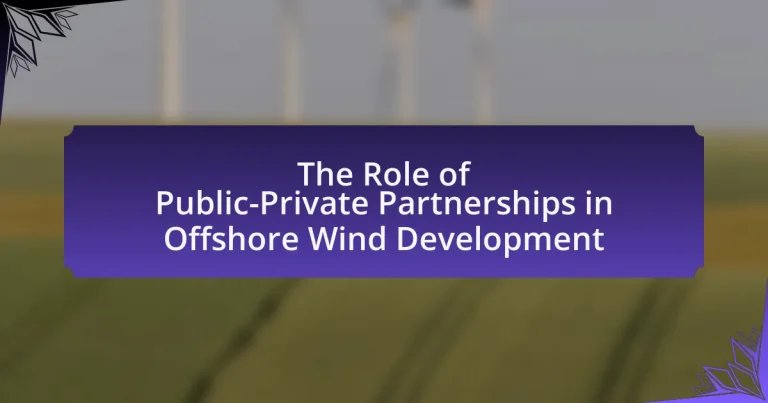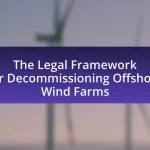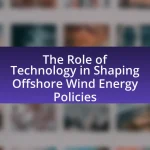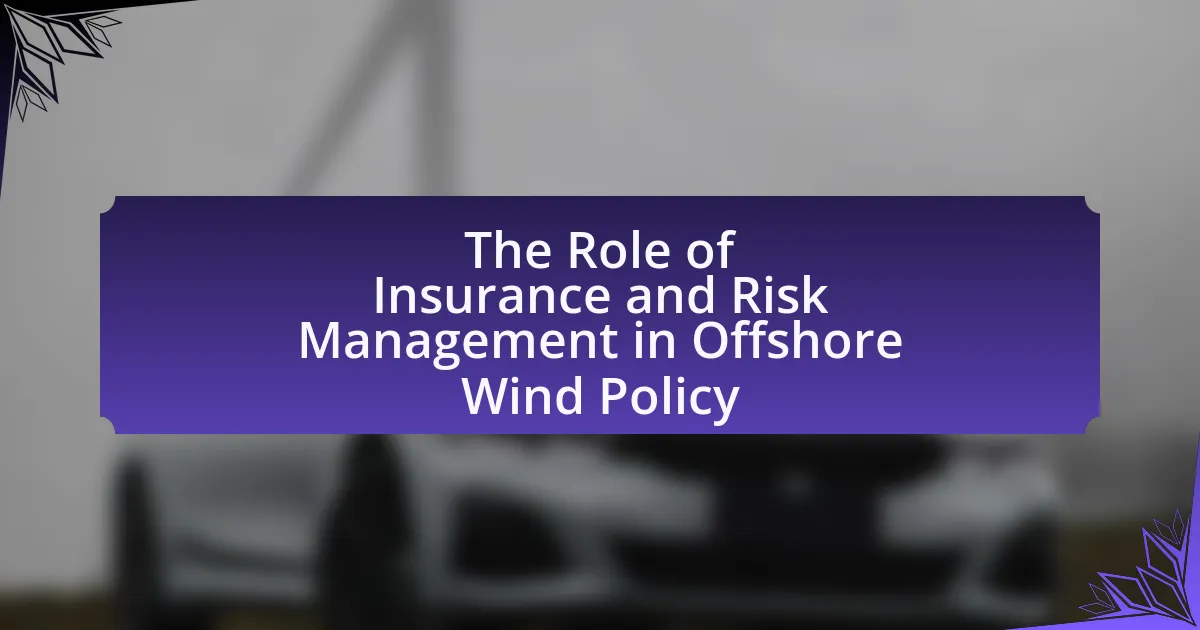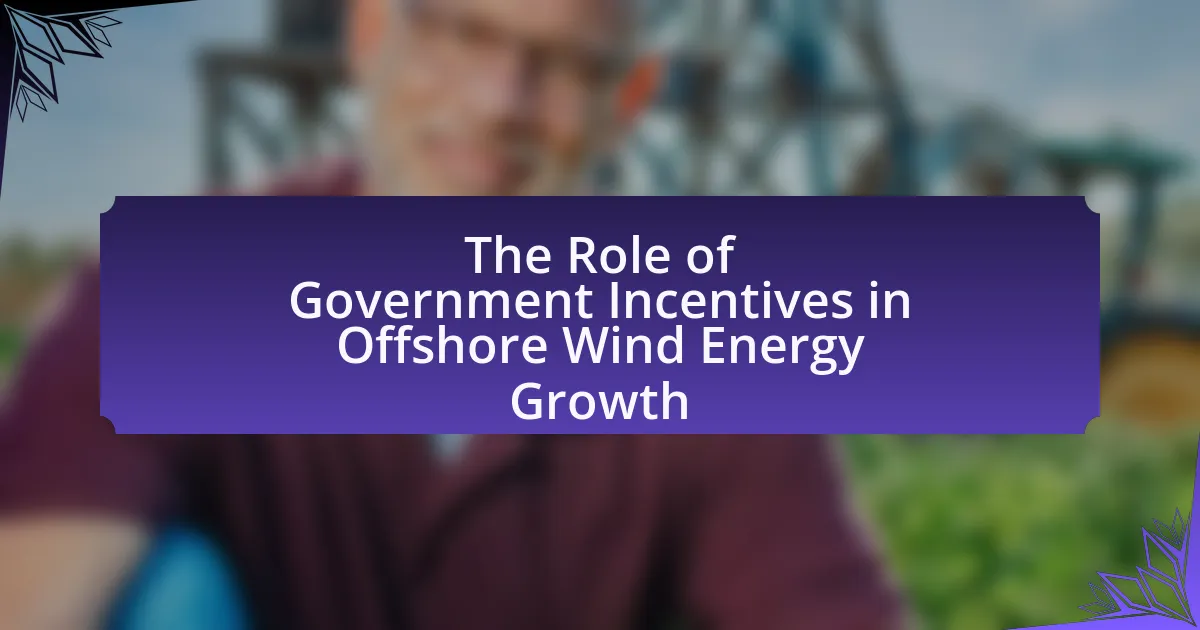Public-Private Partnerships (PPPs) play a crucial role in the development of offshore wind projects by facilitating collaboration between government entities and private sector companies. This article outlines how PPPs function within the offshore wind sector, detailing the roles of public and private entities, the advantages they offer in financing and innovation, and the challenges they face, including regulatory hurdles and financial risks. It also explores future trends, best practices, and lessons learned from successful PPPs, emphasizing the importance of effective communication and stakeholder engagement in achieving successful offshore wind initiatives.
What are Public-Private Partnerships (PPPs) in Offshore Wind Development?
Public-Private Partnerships (PPPs) in offshore wind development are collaborative agreements between government entities and private sector companies aimed at financing, constructing, and operating offshore wind projects. These partnerships leverage public resources and private expertise to enhance project viability, reduce costs, and accelerate the deployment of renewable energy infrastructure. For instance, the UK government has utilized PPPs to support its offshore wind sector, resulting in a significant increase in installed capacity, which reached over 10 gigawatts by 2021, demonstrating the effectiveness of such collaborations in achieving energy transition goals.
How do PPPs function within the offshore wind sector?
Public-Private Partnerships (PPPs) function within the offshore wind sector by facilitating collaboration between government entities and private companies to finance, develop, and operate wind energy projects. These partnerships leverage public resources and regulatory support alongside private sector expertise and capital, enabling large-scale offshore wind developments that might be unfeasible for either party alone. For instance, in the United Kingdom, the government has implemented contracts for difference (CfDs) to provide price stability for developers, which has successfully attracted significant private investment, resulting in a 400% increase in offshore wind capacity from 2010 to 2020.
What roles do public entities play in PPPs for offshore wind projects?
Public entities play crucial roles in public-private partnerships (PPPs) for offshore wind projects by providing regulatory frameworks, financial support, and facilitating stakeholder engagement. They establish the legal and policy environment necessary for project development, ensuring compliance with environmental and safety standards. Additionally, public entities often contribute funding or incentives, such as grants or tax credits, to make projects financially viable. For instance, in the United States, the federal government has implemented tax incentives like the Investment Tax Credit (ITC) to encourage investment in renewable energy. Furthermore, public entities engage with local communities and stakeholders to address concerns and promote transparency, which is essential for gaining public support and ensuring project success.
What roles do private entities play in PPPs for offshore wind projects?
Private entities in public-private partnerships (PPPs) for offshore wind projects primarily serve as developers, investors, and technology providers. They are responsible for financing the projects, which often require substantial capital investment; for instance, the average cost of offshore wind projects can exceed $4 million per megawatt. Additionally, private entities contribute expertise in project management, engineering, and operational efficiency, which are critical for the successful deployment and maintenance of offshore wind farms. Their involvement is essential for leveraging innovation and reducing costs, as evidenced by the significant advancements in turbine technology and installation methods driven by private sector research and development.
Why are PPPs important for offshore wind development?
Public-Private Partnerships (PPPs) are crucial for offshore wind development because they leverage the strengths of both public and private sectors to enhance project financing, risk management, and innovation. By combining public resources and regulatory support with private investment and expertise, PPPs facilitate the large capital investments required for offshore wind projects, which can exceed billions of dollars. For instance, the UK’s offshore wind sector has seen significant growth, with over 40% of its capacity developed through PPPs, demonstrating their effectiveness in mobilizing resources and accelerating project timelines.
What advantages do PPPs offer in financing offshore wind projects?
Public-Private Partnerships (PPPs) offer several advantages in financing offshore wind projects, primarily through risk sharing, access to capital, and enhanced project efficiency. By distributing financial and operational risks between public and private entities, PPPs mitigate the burden on any single party, making projects more attractive to investors. Furthermore, PPPs facilitate access to diverse funding sources, including private investment and government grants, which can significantly lower the overall cost of capital. Studies have shown that projects structured as PPPs often experience improved timelines and cost management due to the combined expertise of public and private sectors, leading to more successful project outcomes.
How do PPPs enhance innovation in offshore wind technology?
Public-Private Partnerships (PPPs) enhance innovation in offshore wind technology by facilitating collaboration between government entities and private companies, which leads to shared resources, expertise, and risk management. This collaboration accelerates research and development efforts, as evidenced by projects like the UK’s Offshore Wind Sector Deal, which aims to increase the capacity of offshore wind energy while driving down costs through innovation. Additionally, PPPs often provide access to funding and investment opportunities that are crucial for developing new technologies, such as floating wind turbines, which have the potential to expand the viability of offshore wind farms in deeper waters.
What challenges do Public-Private Partnerships face in Offshore Wind Development?
Public-Private Partnerships (PPPs) in offshore wind development face several significant challenges, including regulatory complexities, financial risks, and stakeholder alignment issues. Regulatory complexities arise from the need to navigate various governmental policies and permitting processes, which can delay project timelines and increase costs. Financial risks are prevalent due to the high capital investment required for offshore wind projects, making it difficult for private entities to secure funding without adequate public support or guarantees. Additionally, aligning the interests of multiple stakeholders, including government agencies, private investors, and local communities, can lead to conflicts and hinder project progress. These challenges are critical to address for the successful implementation of offshore wind initiatives through PPPs.
What regulatory hurdles impact PPPs in offshore wind projects?
Regulatory hurdles impacting Public-Private Partnerships (PPPs) in offshore wind projects include complex permitting processes, inconsistent regulatory frameworks, and lengthy environmental assessments. These challenges often delay project timelines and increase costs, as developers must navigate multiple layers of federal, state, and local regulations. For instance, the Bureau of Ocean Energy Management (BOEM) oversees leasing and permitting for offshore wind, but varying state regulations can complicate compliance. Additionally, environmental impact assessments can take years to complete, further hindering project advancement.
How do local and national policies affect PPPs in offshore wind development?
Local and national policies significantly influence public-private partnerships (PPPs) in offshore wind development by establishing regulatory frameworks, financial incentives, and operational guidelines. These policies dictate the permitting processes, environmental assessments, and grid access, which are crucial for the feasibility and attractiveness of PPP projects. For instance, national policies may offer subsidies or tax credits that enhance the financial viability of offshore wind initiatives, while local policies can streamline permitting and community engagement, thereby reducing project timelines and costs. The effectiveness of these policies is evidenced by countries like Denmark and Germany, where supportive regulatory environments have led to successful offshore wind projects and robust PPPs, demonstrating the critical role of policy in shaping the landscape of renewable energy development.
What are the risks associated with PPPs in offshore wind projects?
The risks associated with Public-Private Partnerships (PPPs) in offshore wind projects include financial, regulatory, and operational uncertainties. Financial risks arise from the potential for cost overruns and revenue shortfalls, which can jeopardize the project’s viability. Regulatory risks stem from changing government policies and permitting processes that can delay project timelines or increase compliance costs. Operational risks involve challenges related to technology performance, supply chain disruptions, and maintenance issues that can affect energy production and project profitability. These risks are critical to assess, as they can significantly impact the success and sustainability of offshore wind initiatives.
How can stakeholders mitigate challenges in PPPs for offshore wind development?
Stakeholders can mitigate challenges in public-private partnerships (PPPs) for offshore wind development by fostering strong collaboration and communication among all parties involved. Effective stakeholder engagement ensures that diverse interests are aligned, which can reduce conflicts and enhance project efficiency. For instance, establishing clear governance structures and decision-making processes can help streamline operations and address issues proactively. Additionally, sharing risks and responsibilities through well-defined contractual agreements can enhance trust and commitment among stakeholders. Research indicates that successful PPPs in renewable energy projects often rely on transparent information sharing and joint problem-solving approaches, which can lead to improved project outcomes and reduced delays.
What strategies can be employed to improve collaboration between public and private sectors?
To improve collaboration between public and private sectors, establishing clear communication channels and shared goals is essential. This can be achieved through regular stakeholder meetings, joint planning sessions, and the creation of collaborative platforms that facilitate information sharing. Evidence from successful public-private partnerships in offshore wind development, such as the Hornsea Project in the UK, demonstrates that aligning objectives and maintaining open dialogue leads to more effective project execution and innovation. Additionally, implementing incentive structures that reward collaboration can further enhance engagement and commitment from both sectors.
How can risk-sharing mechanisms be structured in PPPs?
Risk-sharing mechanisms in Public-Private Partnerships (PPPs) can be structured through the allocation of specific risks to the party best equipped to manage them. This involves identifying risks such as construction delays, cost overruns, and operational performance, and then assigning these risks to either the public or private sector based on their capacity to mitigate them effectively. For instance, the private sector may assume construction and operational risks, while the public sector may retain regulatory and political risks.
Evidence from successful offshore wind projects, such as the Hornsea One in the UK, demonstrates that clear risk allocation frameworks can enhance project viability and attract investment. In this case, the private partner managed construction risks, while the government provided support through favorable regulatory frameworks, thus sharing the overall risk burden and ensuring project success.
What are the future trends for Public-Private Partnerships in Offshore Wind Development?
Future trends for Public-Private Partnerships (PPPs) in offshore wind development include increased collaboration between governments and private entities, enhanced financing models, and a focus on sustainability and innovation. Governments are likely to implement more supportive regulatory frameworks to attract private investment, as seen in countries like the UK and Germany, which have successfully utilized PPPs to expand their offshore wind capacity. Additionally, innovative financing structures, such as green bonds and blended finance, are expected to emerge, facilitating access to capital for large-scale projects. The emphasis on sustainability will drive partnerships to prioritize environmentally friendly technologies and practices, aligning with global climate goals. These trends indicate a shift towards more integrated and strategic collaborations that leverage the strengths of both public and private sectors in advancing offshore wind initiatives.
How is the global landscape of offshore wind development evolving?
The global landscape of offshore wind development is rapidly evolving, characterized by increased investment, technological advancements, and expanding geographic reach. Countries such as China, the United States, and various European nations are significantly scaling up their offshore wind capacities, with global installed capacity reaching over 35 gigawatts by the end of 2022, according to the Global Wind Energy Council. This growth is driven by supportive government policies, ambitious climate targets, and the decreasing cost of offshore wind technology, which has fallen by nearly 50% since 2010. Additionally, public-private partnerships are playing a crucial role in facilitating this evolution by combining resources, expertise, and risk-sharing, thereby accelerating project development and deployment.
What role will technology play in shaping future PPPs in offshore wind?
Technology will play a crucial role in shaping future public-private partnerships (PPPs) in offshore wind by enhancing efficiency, reducing costs, and improving project viability. Advanced technologies such as digital twins, predictive analytics, and automation will enable better project planning, real-time monitoring, and maintenance optimization, which are essential for maximizing energy output and minimizing downtime. For instance, the integration of artificial intelligence in predictive maintenance can lead to a reduction in operational costs by up to 30%, as evidenced by studies from the International Renewable Energy Agency. Furthermore, innovations in turbine design and floating wind technology will expand the geographical scope for offshore wind projects, making them more attractive for investment and collaboration between public and private sectors.
How are emerging markets adapting PPP models for offshore wind projects?
Emerging markets are adapting Public-Private Partnership (PPP) models for offshore wind projects by integrating innovative financing structures and regulatory frameworks that attract private investment while ensuring public interest. For instance, countries like Brazil and India are implementing hybrid models that combine government incentives with private sector expertise, facilitating the development of large-scale offshore wind farms. These adaptations often include risk-sharing mechanisms, such as fixed tariffs or power purchase agreements, which provide revenue certainty for investors. Additionally, emerging markets are increasingly focusing on local content requirements to stimulate domestic industries and create jobs, thereby enhancing the socio-economic benefits of offshore wind projects.
What best practices can enhance the effectiveness of PPPs in offshore wind development?
Best practices that can enhance the effectiveness of Public-Private Partnerships (PPPs) in offshore wind development include establishing clear governance structures, ensuring transparent communication, and aligning incentives among stakeholders. Clear governance structures facilitate decision-making and accountability, which are crucial for project success. Transparent communication fosters trust and collaboration between public and private entities, reducing misunderstandings and conflicts. Aligning incentives ensures that both parties work towards common goals, such as maximizing efficiency and minimizing costs. For instance, successful projects like the Hornsea One offshore wind farm in the UK demonstrate that effective stakeholder engagement and risk-sharing mechanisms can lead to timely project delivery and cost reductions.
How can effective communication strategies improve PPP outcomes?
Effective communication strategies can significantly enhance Public-Private Partnership (PPP) outcomes by fostering transparency, trust, and collaboration among stakeholders. Clear communication ensures that all parties involved in offshore wind development understand their roles, responsibilities, and expectations, which minimizes misunderstandings and conflicts. For instance, a study by the World Bank highlights that effective stakeholder engagement through regular updates and feedback mechanisms can lead to a 30% increase in project efficiency. Additionally, transparent communication about project goals and progress can build public trust, which is crucial for securing community support and regulatory approvals. Thus, implementing robust communication strategies directly correlates with improved performance and success rates in PPP projects.
What lessons can be learned from successful PPPs in offshore wind projects?
Successful public-private partnerships (PPPs) in offshore wind projects demonstrate the importance of collaboration, risk-sharing, and long-term planning. These partnerships effectively combine public sector support, such as regulatory frameworks and financial incentives, with private sector expertise in technology and project management. For instance, the Hornsea One project in the UK, which is the world’s largest offshore wind farm, showcases how a strong partnership between Ørsted and the UK government facilitated investment and innovation, leading to a significant reduction in costs—over 50% since 2015. Additionally, successful PPPs highlight the necessity of stakeholder engagement and community support, as seen in the Block Island Wind Farm in the US, where local involvement was crucial for project acceptance and success. These lessons underscore that effective collaboration and strategic alignment between public and private entities are vital for advancing offshore wind development.
